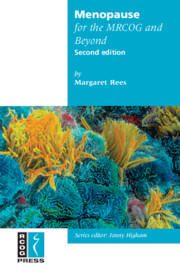Book contents
- Frontmatter
- Contents
- Preface
- Abbreviations
- 1 Definitions and controversies
- 2 Explaining risk
- 3 Systemic hormone replacement therapy
- 4 Non-HRT options for osteoporosis
- 5 Diet and lifestyle
- 6 Alternative and complementary therapies
- 7 Vasomotor symptoms, urogenital and sexual problems
- 8 Osteoporosis and autoimmune arthritis
- 9 Breast disease
- 10 Benign and malignant gynaecological disease
- 11 Premature menopause
- 12 Women with concomitant medical conditions
- Index
10 - Benign and malignant gynaecological disease
Published online by Cambridge University Press: 05 July 2014
- Frontmatter
- Contents
- Preface
- Abbreviations
- 1 Definitions and controversies
- 2 Explaining risk
- 3 Systemic hormone replacement therapy
- 4 Non-HRT options for osteoporosis
- 5 Diet and lifestyle
- 6 Alternative and complementary therapies
- 7 Vasomotor symptoms, urogenital and sexual problems
- 8 Osteoporosis and autoimmune arthritis
- 9 Breast disease
- 10 Benign and malignant gynaecological disease
- 11 Premature menopause
- 12 Women with concomitant medical conditions
- Index
Summary
The major concern is the estrogen dependence of these conditions and whether estrogen-based therapy will stimulate growth. Also many treatments for gynaecological cancer may induce a premature menopause resulting in concerns about osteoporosis and cardiovascular disease.
Benign disease
FIBROIDS
Uterine leiomyomas are benign smooth muscle tumours and are the most common gynaecological tumours in women of reproductive age. Uterine leiomyomas clinically affect 25—30% of American women; however, an incidence of 77% has been reported. They are more common in African American women, with some studies indicating they are diagnosed three times more frequently than in white women. They are often associated with reproductive and gynaecological disorders ranging from infertility and pregnancy loss to pelvic pain and excessive uterine bleeding. They are steroid-dependent tumours that rarely progress to malignancy and regress at the menopause.
There is a concern that they may become enlarged with estrogen treatment and cause heavy or painful withdrawal bleeds, so the woman should be advised of this. The evidence of the effect of different types of HRT, including tibolone, on fibroid growth is poor. Ultrasound examinations may be helpful in documenting the fibroids and, if clinically indicated, regular pelvic examinations are recommended. Limited data suggest that raloxifene shrinks fibroids.
ENDOMETRIOSIS
Endometriosis is defined as endometrium in sites other than the uterine cavity; this ectopic endometrium undergoes a similar morphological pattern to the eutopic (normally placed) endometrium during the menstrual cycle.
- Type
- Chapter
- Information
- Menopause for the MRCOG and Beyond , pp. 85 - 90Publisher: Cambridge University PressPrint publication year: 2008

